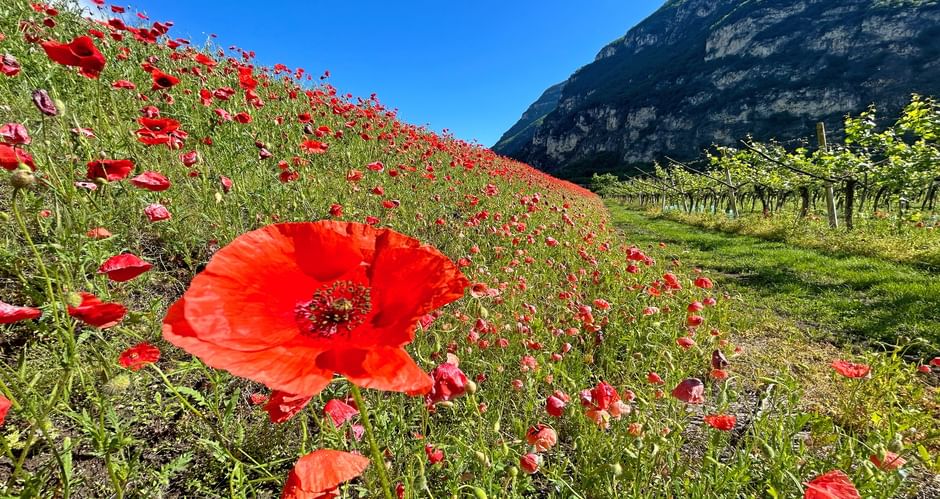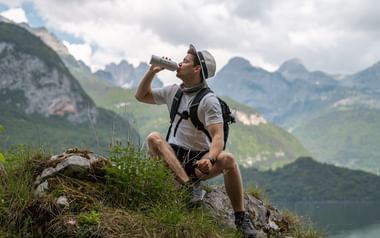-
1. Check the weather forecast:
Stay updated on the local weather. If necessary, ask at the hotel reception about locally recognized weather apps or other sources they can recommend for checking the weather. Ask them about their view on the weather situation for the coming days.
2. Prepare for weather changes:
Even if the weather forecast looks promising, the weather in mountainous areas and open plains can quickly change. Always pack an extra warm sweater, a rain jacket, and a windbreaker, even if it looks like it will be a sunny day. Layered clothing allows you to quickly adapt to changing weather conditions.
3. Be aware of local weather warnings:
Keep an eye out for warnings about extreme weather such as thunderstorms, heavy rain, storms, etc. These conditions can make hiking and cycling dangerous. If warnings are issued, you should inquire locally and, if necessary, call the local emergency number to discuss the situation.
You will find the number on your departure voucher.
4. Prepare for sun and heat:
If you are hiking or cycling in hot weather, make sure to protect yourself from the sun. Wear a hat, sunglasses, and use high-factor sunscreen. Drink plenty of water to avoid dehydration and plan breaks in shady areas when possible.
5. Share your plans:
Always tell someone where you plan to hike/cycle and when you expect to be back. That way, someone knows where you are if you run into trouble.
On the following page, we have elaborated a bit on what to be aware of in heat and heavy rainfall.
Hot Days
Feeling the warmth on our skin when we take a walk on a summer day can work wonders for our health and well-being. However, heat can also require special precautions, and good preparation is key to good experiences. There is no simple definition of when it is too hot to hike or cycle, as everyone has varying levels of tolerance and sensitivity to heat. However, it can become so hot that it is recommended to avoid being in the sun during the hottest time between 11 a.m. and 3 p.m. In those cases, you should seek shade, especially if you have underlying medical conditions that make you more vulnerable to the effects of hot weather.
On very hot days, we recommend planning your hiking/cycling according to local weather conditions:
- Make the plan for the walking/cycling stage the evening before you go out – and revise it in the morning before departure.
- Get out on the route early. If this means that you must leave before the hotel serves breakfast, ask at the reception about the possibility of getting a packed breakfast.
- A very early start will make it easier to take a break in the midday sun.
- Stay hydrated. Drink plenty of water before, during, and after hiking/cycling.
- Avoid alcohol, caffeine, and sugary drinks. Bring plenty of water on the route. - Remember sunscreen, sunglasses, and a hat that shades your face.
- Take it easy. High pulse and very hot weather are not a good combination.
Take breaks in the shade and cool yourself down with cold water on your face and wrists. - Follow your own instincts. Choose an easier route if there are alternative routes described in the roadbook, and do not be too proud to skip a hiking/cycling day and instead take a taxi or public transport to the next accommodation.
- If you are traveling with a dog, remember that the dog's paws can be particularly exposed on hot surfaces. Paw balm or shoes may be necessary.
Symptoms include shivering, confusion, and fatigue.
These precautions are intended as helpful guidelines for preparing for your upcoming trip in case of various weather-related challenges.
In the end, you must take care of yourself and do what you feel comfortable with.
Be aware of symptoms of hypothermia.
Hypothermia is not just a winter concern; it can occur if you are wet and exposed to cold wind.
Seek shelter where you can warm up and remove wet clothing. Contact a doctor if needed. Never leave a marked trail in mountains or nature areas to get ahead faster. If there are heavy rainstorms, storm warnings, or other weather phenomena that make you unsure, contact the local emergency number and ask for their recommendations.
The number is on your departure voucher.
Heavy Rainfall
A little rain cannot ruin the experience of a good hiking or cycling holiday, but should you be affected by more extreme weather, the situation can change. You should always assess what makes the most sense for you and your situation, but here are some guidelines to follow:
Consider the routes you are heading out on and how the weather will affect them:
- If you are hiking in mountains where there is a possibility of washed-out trails or landslides, consider how you can plan your route as safely as possible.
- Perhaps start earlier or later in the day.
- Check if there is an alternative option for the day's stage that is better suited to bad weather.
- If you are cycling or hiking on open plains, assess what is needed to keep you dry and warm all the way.
- Have good rain gear and preferably wool or thermal clothing that you can take on and off as needed.
- Remember that it is easier to stay dry than to dry off afterward, so put on waterproof layers at the first drops. This is especially important in cool weather.
If a thunderstorm is brewing, seek shelter and let it pass before continuing. If dense fog arises, assess the situation:
- What kind of landscape are you in? Evaluate whether it is safe to continue hiking or cycling.
- Check weather forecasts. If it looks like it will clear up, wait.
Symptoms often include headache, dizziness, nausea, and confusion.
Be aware of symptoms of heat stroke.
If you or your fellow travelers begin to experience these, take your precautions:
Stop hiking/cycling and get in the shade. Contact a doctor if needed. Never leave a marked trail in mountains or nature areas to get ahead faster.


